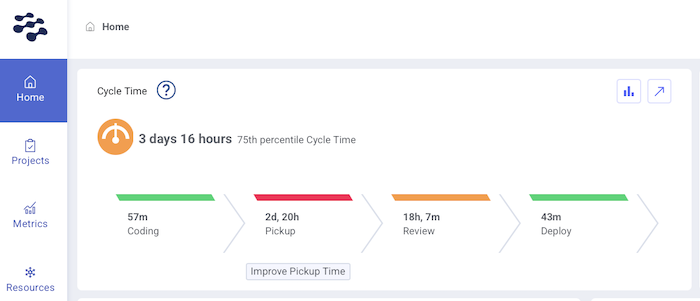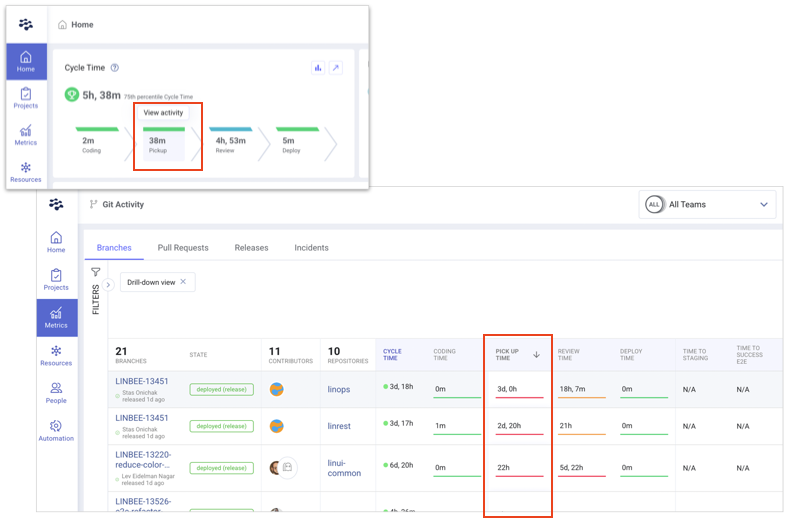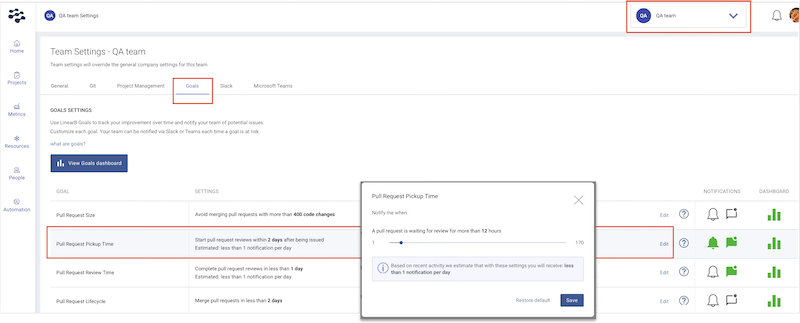Table of Contents
Strategies to Identify and Reduce High Pickup Time
Continuous improvement thrives when your team responds quickly to pull requests (PRs) and keeps the review process moving smoothly. High pickup time can hinder your team's efficiency, as PRs that rem…
Continuous improvement thrives when your team responds quickly to pull requests (PRs) and keeps the review process moving smoothly. High pickup time can hinder your team's efficiency, as PRs that remain unreviewed for long periods delay the entire cycle. Elite teams aim for a pickup time of under 24 hours, while a PR should never go unreviewed for more than 48 hours.
If your pickup time is high, the Home dashboard will display Pickup in red.


Identifying High Pickup Time
- Team Level: In the Home dashboard, set your view to All Teams, and click the Cycle Time's Pickup metric to identify delays in pickup time across teams.

- Team Member Level: In the People Team > Activity page, select the required team, and hover over the Cycle Time metric for each member to identify team members whose PRs are not being reviewed promptly.

- Pull Request Level: In the Metrics Pull Requests tab, sort pull requests using the Review Request Hanging filter. This helps you spot any PRs that are hanging for more than 3 days. (Use the Start/End Date filter to view PRs that are hanging for less than 3 days.)


Causes of High Pickup Time
- Lack of Awareness: Sometimes PRs go unnoticed by the team. Use Slack alerts to notify channels when a PR has been hanging for too long, ensuring the team is aware and can take action.
- Team Overload: High workloads or excessive multitasking can prevent team members from reviewing PRs promptly. Use the Pulse View to monitor active work and make sure the team’s workload is balanced.
- Large Pull Requests: Larger PRs require more time to review. Encourage breaking up tasks into smaller, manageable chunks to streamline the review process.
- Unclear Review Ownership: If a reviewer isn’t clearly assigned to a PR, it can get delayed. Pair developers with dedicated reviewers and use WorkerB personal alerts to notify team members when they’ve been assigned a review.

Strategies to Reduce Pickup Time
Set Up Slack Alerts for Hanging PRs
Configure Slack alerts to notify the team when a PR has been waiting for review for an extended period. Set the alert threshold to 1-2 days to catch delayed PRs early and keep the review process on track.
- To create the Slack alert for your team, follow these steps:
- In the LinearB side menu, click Settings.
- In the Teams drop-down, select the team who you want to alert.
- Navigate to the Goals tab.
- Edit the Pull Request Pickup Time goal.
- Set the alert threshold to your required time frame, for example 1 day or 12 hours.
- Click Save.
- Enable the Pull Requests Merged without Review alert to prevent unreviewed code from being merged due to missed or overlooked PRs. This proactive measure ensures all code changes are properly reviewed, maintaining code quality, and reducing potential risks.

Once configured, your team's Slack channel will receive alerts about any hanging PRs. Team members can easily click the link in the notification to access the PR directly from Slack, ensuring faster reviews and streamlined workflows.
Enable WorkerB Personal Slack Alerts
WorkerB personal Slack alerts provide real-time direct messages, keeping team members informed about their PRs. Alerts are sent when PRs are assigned to them or when comments and requests are made on their own PRs.
If Slack integration is already enabled, inviting team members to use WorkerB is simple—just type /lb invite in Slack. Team members can activate WorkerB on their own by using the command /lb pref.
Additionally, the following commands are available for tracking and managing PRs:
/lb updates: View all updates on your PRs./lb reviews: See all PRs assigned to you for review./lb prs: List all open pull requests created by you.
These tools ensure streamlined communication and efficient PR management for your team.
Build a Metrics Dashboard
Use LinearB’s Metrics tab to build a custom metrics dashboard that tracks Pickup Time, PR Size, and Active Branches. This will allow you to monitor trends and identify potential bottlenecks in the review process.
Monitor for Large PRs and High Work in Progress
Regularly check the for large PRs and the Pulse View for team workloads. Managing PR size and balancing work assignments will help reduce pickup time.
By implementing these strategies, your team can reduce pickup time, ensuring faster code reviews and a more efficient development cycle.
How did we do?
Managing Large Pull Requests
Troubleshooting: Why Are My Pull Requests Not Showing?